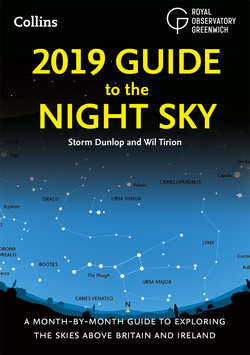Читать книгу 2019 Guide to the Night Sky: Bestselling month-by-month guide to exploring the skies above Britain and Ireland - Wil Tirion - Страница 7
ОглавлениеComets and the Moon
Comet C/2006 P1 McNaught, imaged on 20 January 2007, from Lawlers Gold Mine, Western Australia (Photographer: Sjbmgrtl).
Comets
Although comets may occasionally become very striking objects in the sky, their occurrence and particularly the existence or length of any tail and their overall magnitude are notoriously difficult to predict. Naturally, it is only possible to predict the return of periodic comets (whose names have the prefix ‘P’). Many comets appear unexpectedly (these have names with the prefix ‘C’). Bright, readily visible comets such as C/1995 Y1 Hyakutake & C/1995 O1 Hale-Bopp or C/2006 P1 McNaught (sometimes known as the Great Comet of 2007) are rare. Comet Hale-Bopp, in particular, was visible for a record 18 months and was a prominent object in northern skies. Comet McNaught was notable for its multiple tail structure. Most periodic comets are faint and only a very small number ever become bright enough to be readily visible with the naked eye or with binoculars. One comet, 46P/Wirtanen, was expected to become visible in binoculars in October 2018. It is well placed in the northern sky in the first few months of 2019. The accompanying charts show its path at its brightest during early 2019 until March, when it is expected to fade below magnitude 10.
The Moon
The monthly pages include diagrams showing the phase of the Moon for every day of the month, and also indicate the day in the lunation (or age of the Moon), which begins at New Moon. Although the main features of the surface – the light highlands and the dark maria (seas) – may be seen with the naked eye, far more features may be detected with the use of binoculars or any telescope. The many craters are best seen when they are close to the terminator (the boundary between the illuminated and the non-illuminated areas of the surface), when the Sun rises or sets over any particular region of the Moon and the crater walls or central peaks cast strong shadows. Most features become difficult to see at Full Moon, although this is the best time to see the bright ray systems surrounding certain craters. Accompanying the Moon map on the following pages is a list of prominent features, including the days in the lunation when features are normally close to the terminator and thus easiest to see. A few bright features such as Linné and Proclus, visible when well illuminated, are also listed. One feature, Rupes Recta (the Straight Wall) is readily visible only when it casts a shadow with light from the east, appearing as a light line when illuminated from the opposite direction.
The dates of visibility vary slightly through the effects of libration. Because the Moon’s orbit is inclined to the Earth’s equator and also because it moves in an ellipse, the Moon appears to rock slightly from side to side (and nod up and down). Features near the limb (the edge of the Moon) may vary considerably in their location and visibility. (This is easily noticeable with Mare Crisium and the craters Tycho and Plato.) Another effect is that at crescent phases before and after New Moon, the normally non-illuminated portion of the Moon receives a certain amount of light, reflected from the Earth. This Earthshine may enable certain bright features (such as Aristarchus, Kepler and Copernicus) to be detected even though they are not illuminated by sunlight.
